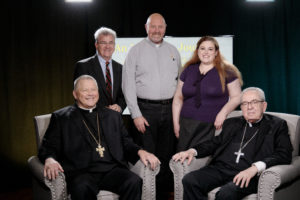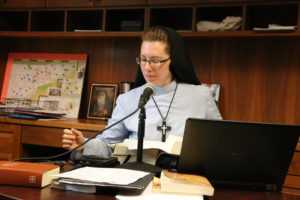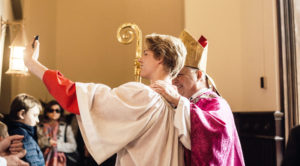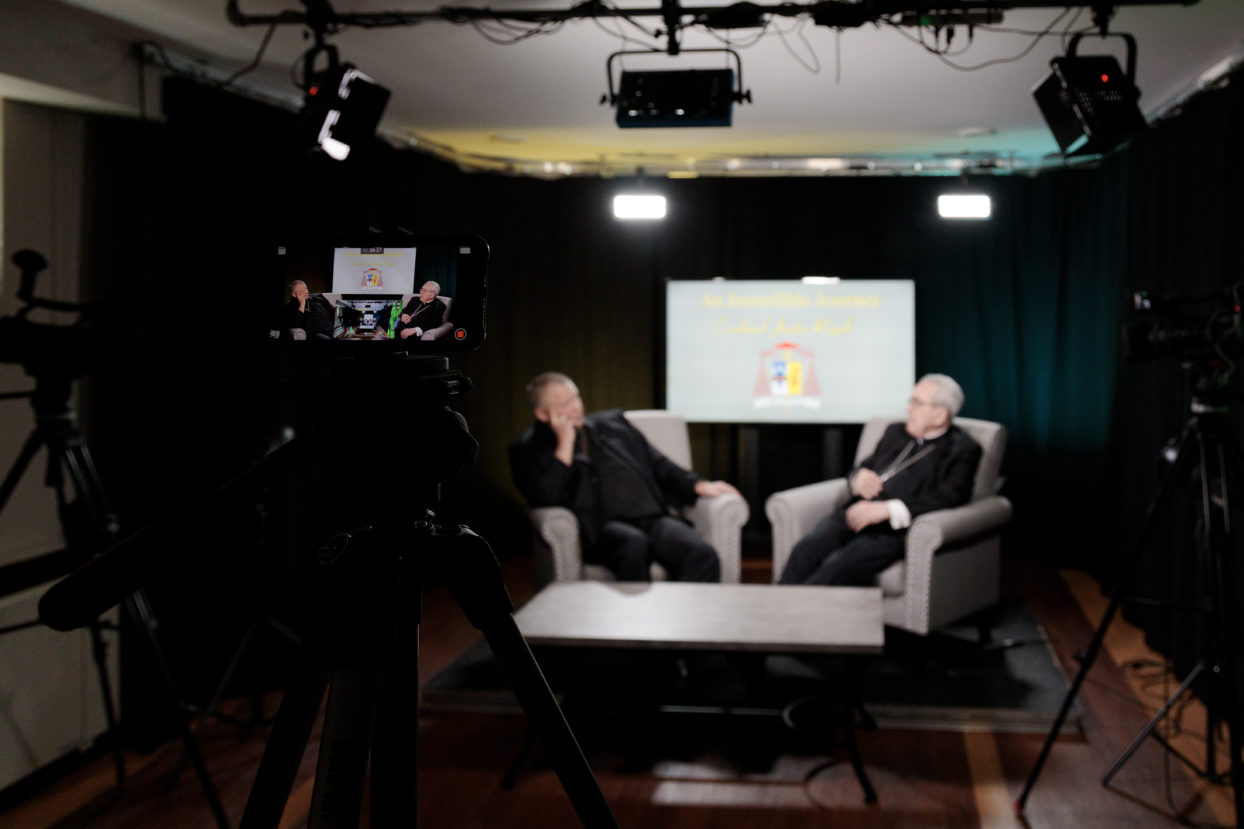Catholic community increasingly relies on technology during the pandemic
By Emily Booker
Photography by Stephanie Richer
“He said to them, ‘Go into all the world and preach the Gospel to all creation.'”— Matthew 16:15.
When you first hear the word “evangelization,” what do you picture? Maybe a minister preaching on a street corner, or missionaries going door to door, or a packed church on Easter Sunday, or the Apostles spreading out to far off lands, two by two, to share the Good News.
Now more than ever, evangelization is taking place at a distance, through a screen. While many people self-isolated this spring during the coronavirus pandemic, the Catholic Church worked to make community available without parish walls or gatherings. Media, such as livestreams, podcasts, virtual meetings, and social sites, have allowed everyone to share an experience while maintaining “social distance.”
The Church has always used the latest technology to spread Christ’s message, from the printing press, to the radio and television, to the Internet. For those who cannot be reached in person, the message of Christ’s love is still accessible in the palm of their hands.
The Diocese of Knoxville works to reach as many people as possible with informative and spiritually nourishing news from the diocese. This is done through the diocese’s Office of Communications and Media, which incorporates many means to be as accessible as possible.
The main source of news is The East Tennessee Catholic newspaper and magazine, published monthly. There also is the electronic weekly newsletter, DioNotes. Both are also shared online.
News stories and events also are shared on the diocesan social media accounts, such as Facebook, Twitter, and Instagram.
 Bishop Richard F. Stika has championed the use of new media and new approaches to reach parishioners and the public.
Bishop Richard F. Stika has championed the use of new media and new approaches to reach parishioners and the public.
“We use what’s available. St. Paul, when he would go around, he would go to the temple or town square, get up on a box maybe or a top step, and start preaching that way. With social media, it’s just another way to reach out to people. More and more bishops are utilizing it. The Holy Father does. But I think we use the tools that are available, just like centuries ago with the Gutenberg Bible, when they began to use printing presses to share information. At one time, it was the town crier who would yell the news, or they would post information on a bulletin board in the town square. So now it’s these other social platforms,” the bishop said.
The diocese now has a media studio, located on the campus of the Cathedral of the Most Sacred Heart of Jesus, for recording interviews, messages from Bishop Stika, and the diocesan TV show, A Call to Discipleship, hosted by Bishop Stika. The studio also includes storage for all video, audio, and lighting equipment.
Jim Wogan, director of communications for the diocese, Emily Booker, communications specialist for the diocese, and Deacon Scott Maentz help behind the camera with producing, running the cameras, and editing.
Quality video production helps the bishop share his thoughts and messages across the diocese in a personal way.
“All of our communications efforts are an attempt to bring us closer together as a Catholic family,” Bishop Stika said. “We really are a family, and we need to stay in touch with our family members as the body of Christ.”
Bishop Stika sees the role of diocesan media in two ways. First, it’s informative and shares information in the diocese. And secondly, it adds a spiritual dimension to news that secular media cannot.
“I think it should be spiritually uplifting. We live in a world where most of the media in the outside, secular world is more concerned about negative things that are going on, and also, kind of short term … on to the next thing. Whereas the Church can do a lot in terms of calling attention to ongoing moral issues or social issues. And I think that’s what we strive to do,” he said.
Sharing spiritually uplifting content has been the focus of the diocese’s efforts lately as people within the diocese and outside it are struggling with isolation, job loss, and less access to the sacraments due to the pandemic.
“Some of this so-called new media can really be a front door to our parishes. It can provide parishioners with news; it can provide a guest with directions; it can provide a stranger with an invitation; it can provide a skeptic with resources to become a believer. All of these things, whether in print or electronic, can be someone’s first look into the beauty of the Catholic faith. Utilizing these tools allows us to do what the apostles did, without getting wet, or dusty, or killed,” Mr. Wogan said.
“The diocese is fortunate. We have some very talented people in communications, both in print and in electronic, who understand why we’re doing this and we’re also fortunate to have a bishop who doesn’t need to be convinced to try new things. Bishop Stika is always pushing, in a very pastoral way, to get our message out to a Catholic and non-Catholic audience,” he added.
After public Masses were suspended in the Diocese of Knoxville on March 20, many priests began livestreaming Masses so that parishioners could still watch and feel connected. While not the same as attending Mass, a livestream Mass still offered a time set aside for worshiping God, the daily readings and prayers, and a chance to make an act of spiritual Communion.
Spiritual Communion might not be something many were familiar with before the pandemic, but it became a regular part of many parishioners’ spiritual lives. It is not a substitute for receiving the Eucharist, but it does provide a way for a person to unite himself or herself to God through prayer. The Act of Spiritual Communion can be prayed at any time and in any place.
An example of an act of spiritual Communion are the words of St. Alphonsus Ligouri: “My Jesus, I believe that You are present in the Blessed Sacrament. I love You above all things, and I desire You in my soul. Since I cannot now receive You sacramentally, come at least spiritually into my heart. As though You were already there, I embrace You and unite myself wholly to You; permit not that I should ever be separated from You. Amen.”
 Priests still celebrated Mass every day, even though for health safety, the public could not attend for more than two months. Even now, seniors and vulnerable residents are still encouraged to remain home. Livestreams help priests reach out to their parishioners and help them stay connected to their parish and the Mass.
Priests still celebrated Mass every day, even though for health safety, the public could not attend for more than two months. Even now, seniors and vulnerable residents are still encouraged to remain home. Livestreams help priests reach out to their parishioners and help them stay connected to their parish and the Mass.
“During all of this, the Masses never stopped, and the diocese continues to evangelize; we are just learning to do it in different ways,” Bishop Stika said.
“I urged our priests, and especially the pastors, to stay connected. They didn’t have to use livestreaming, but many of them did, and for some there was a learning curve when it came to understanding the technology. Some of our pastors were already doing livestreaming of Masses, and some of the parishes were already set up. Others weren’t doing it, but they learned how to fast, very fast,” he added.
This proved a popular move among the faithful, as thousands began checking in online every Sunday to pray during their parish’s livestream of Mass.
“Based on the viewership numbers I have seen, the streaming of Masses allowed us to give our parishioners something that many of them definitely wanted: the opportunity to participate in the Mass and receive the sacraments spiritually, even if they couldn’t be there in person,” Bishop Stika said.
In addition to Mass, priests around the diocese are sharing videos of prayer, reflections, and music to provide their flocks with encouraging content and let them know that their pastors still are ministering to them, albeit remotely.
The Office of Communications and Media reached out to help some parishes set up livestreaming capabilities or update their websites or social media accounts. Being accessible online became increasingly important when physical gatherings could not take place. People still needed connection.
“I suggested that the priests stay connected through any means possible — letters, e-mails, phone calls. It’s all about showing that you care and that we didn’t forget about our parish families — even if we couldn’t see them in the pews,” Bishop Stika said.
Gospel on the Go
Podcasting continues to grow in popularity, offering listeners a multitude of shows and topics. The Diocese of Knoxville offers three podcasts: Homilies shares the homily from the Cathedral of the Most Sacred Heart of Jesus’ 9 a.m. Sunday Mass each week as well as special holiday Masses; Inside the Diocese of Knoxville interviews people from all across the diocese to share the range of devotions and ministries of the Catholic Church in East Tennessee; and Scripture and the Spiritual Life takes a deep look at Scripture, theology, and virtues.
Bishop Stika noted that podcasts are useful because they are so accessible. People can fit podcasts into their own schedules in a way that an in-person Bible study might not work.
“I think those kinds of things that you can use on your own time are so important,” he said. “So I think if there’s a podcast on moral formation, or on Scripture, it leads people to Christ. Or you can have a podcast and then a discussion between people on what they’re talking about. And you might agree with one, but it might open your eyes to another opinion. So those all bring it to encounters with Christ.”
 Sister Anna Marie McGuan, RSM, host of Scripture and the Spiritual Life and director of Christian formation for the Diocese of Knoxville, also noted the flexibility of podcasting as a big plus. The diocesan women’s retreat in February was filled to capacity, but those who couldn’t attend were at least able to listen to her talks later on her podcast.
Sister Anna Marie McGuan, RSM, host of Scripture and the Spiritual Life and director of Christian formation for the Diocese of Knoxville, also noted the flexibility of podcasting as a big plus. The diocesan women’s retreat in February was filled to capacity, but those who couldn’t attend were at least able to listen to her talks later on her podcast.
“What I like about this particular medium, the podcast medium, is the ability for people to listen to it at their leisure so they can do it while they’re walking or exercising, they can do it while they’re cleaning the house, or whatever,” Sister Anna Marie said.
“Also they can re-listen to it several times, which I’ve also been told people do. They’ll listen to the episodes several different times in order to make sure that they kind of glean from it everything that they can, which is great,” she added.
Sister Anna Marie uses her podcast to share her knowledge of Scripture with a wider audience. Some episodes are from her talks on faith recorded around the diocese. Other episodes are deep-dive Bible studies, where she shares her knowledge of Greek, history, and theology to see sacred Scripture in new ways.
“I think there’s a real hunger for a deeper understanding of the Word of God across the board. And so that is my go-to content,” she said. “When I’m traveling and giving talks, I record the talks that I give, and those are on all sorts of different topics. A lot of times I’ll bring in Scripture, but the theme of the particular talk might be something else, like the spiritual life, or theology, or a particular aspect of the Church’s teaching. I’ve done quite a bit on Theology of the Body. It’s all Catholic theology, Catholic teaching, but as far as the content, it’s not relegated to just Theology of the Body or just Scripture. It’s really a smattering of all sorts of different things, which I think keeps people’s interest — that’s my hope.
“It keeps it interesting for me, too. I really enjoy giving the in-depth commentaries on Scripture when I’m in my office and I can just dive into the text.”
Like and Share
Perhaps the biggest change in the technological landscape in the past few years has been the rise of social media. People spend lots of time reading and sharing on platforms such as Facebook, Twitter, and Instagram.
The Diocese of Knoxville maintains social media accounts to share information and inspiration, reaching people wherever they are.
Bishop Stika is known for his presence on social media, where he maintains his own personal Facebook, Twitter, and Instagram accounts. He likes sharing parts of his daily life and considers it part of his pastoral approach to reaching people in the diocese.
“When I go to a parish, I hand my camera off, and people take pictures, and I’ll make comments about this or that. It’s a good way that people see my daily life,” he said, while also noting that “selfie” photos have become part of his social media portfolio.
 “Sometimes people only see me when I show up for confirmations. I’ve always believed that I’m a joyful person and happy, so sometimes I’ll put humorous things on there. And other times I let people know who I am,” the bishop said, joking, “If anyone doesn’t know I like White Castles and Cardinals baseball, then they’ve never read my Facebook.”
“Sometimes people only see me when I show up for confirmations. I’ve always believed that I’m a joyful person and happy, so sometimes I’ll put humorous things on there. And other times I let people know who I am,” the bishop said, joking, “If anyone doesn’t know I like White Castles and Cardinals baseball, then they’ve never read my Facebook.”
He also realizes that social media often can be impersonal. People are more likely to say rude or untruthful comments when they are hidden under a false identity and the safety from behind a screen.
“In some ways I find Twitter more and more becoming what I call a cesspool, just because of the inauthenticity of a lot of people on there,” Bishop Stika said. “It’s like everybody’s an expert. And people have a tendency to be drawn to those people that they may agree with, then all of a sudden you’ve got this pool of people with a distortion of truth.
“When you’re in social media, there is no discussion. You just post and post and repost. There’s no emotion, there’s no connection, there’s no fact-checking. Whereas if you’re in a parish setting, let’s say a Bible study, there’s dialogue, there’s conversation, there’s eyeball to eyeball. You don’t have that on social media.”
Social media can keep us connected to family and friends and help us find supportive groups and resources. But it can also feed us misinformation, make us jealous of others’ online persona, or bring out our worst characteristics behind anonymity. It is our responsibility to use it wisely.
Every Christian has the call to evangelize. It doesn’t mean preaching or hosting your own podcast. It means sharing the Good News. In each of our daily interactions, even our actions online, we should be mindful of reflecting Christ and the mission of the Church.
St. Francis de Sales, patron saint of writers and journalists, has some more specific suggestions:
“Let your words be kindly, frank, sincere, straightforward, simple, and true; avoid all artifice, duplicity, and pretense, remembering that, although it is not always well to publish abroad everything that may be true, yet it is never allowable to oppose the truth. Make it your rule never knowingly to say what is not strictly true, either accusing or excusing, always remembering that God is the God of Truth.”
One piece of advice Sister Anna Marie has is continue to read and study. Although technology has accustomed us to quick and instant content, it is good to slow down and dive deep. Reflect before you hit that send button.
“One thing that Bishop [Robert] Barron frequently says is that if you want to be an evangelist of the new media, you’ve got to master the old media. He’s like read, read, read, read, read,” she said.
“And that’s what I try to do. I try to study all the time; any free time that I have I want to be studying and thinking and trying to understand better the material, which is our faith. As much as I love podcasts, I love books. I want to read, and I want to understand. Read, everybody, read!”
Media can never fully replace a physical gathering. The Church is a community meant to gather and worship together. A face-to-face conversation, a welcoming handshake, or a supportive hug can never truly be duplicated. But when we cannot gather — when distance or illness, or even just a hesitancy keeps someone from the doors of a church — the Church reaches out to meet us where we are — in our living rooms, on our phones, scrolling through social media looking for some connection.
In addition, new media can reach those who might never otherwise walk through a church door. Online we can encounter those we might not see in our day-to-day lives and form relationships that lead to Christ. We don’t have to pack up and travel to be missionaries; we just have to be willing to share the truth where we are and with the tools we have.
In 2014, for World Communications Day, Pope Francis said, “Communication is a means of expressing the missionary vocation of the entire Church; today the social networks are one way to experience this call to discover the beauty of faith, the beauty of encountering Christ. In the area of communications too, we need a Church capable of bringing warmth and of stirring hearts.”
There can be a lot of clatter and misinformation online, but there is also a lot of community and truth to be found. We are as responsible for how we conduct ourselves online as we are in real life. As Christians, each of us is called to evangelize in our own way. What we as individuals and as the Church post, like, and share has the potential to draw someone closer to an encounter with Christ.


Comments 1
Some very good ideas. Loved the “read, read, read”. You can’t share what you don’t know